The 1947 Wheat Penny, also known as a Lincoln penny, is a fascinating piece of American coinage. But what exactly gives this coin its name, and how valuable is it? We’ll dive into the details of its value, highlighting the influence of the mint mark and condition. Additionally, we’ll take a look at the coin’s history and design, shedding light on its significance.
Let’s get started!
1947 Wheat Penny Value Breakdown:
The value of a 1947 Wheat Penny can vary depending on the condition of the coin and the mint mark (or lack thereof). Here’s a breakdown of the approximate value for coins in different grades:
| Type | MS60 | MS63 | MS65 | MS67 |
|---|---|---|---|---|
| 1947 No Mint Mark | $5 | $10 | $26 | $2,200 |
| 1947 D | – | $11 | $18 | $325 |
| 1947 S | $2 | $8 | $24 | $240 |
History of the 1947 Wheat Penny
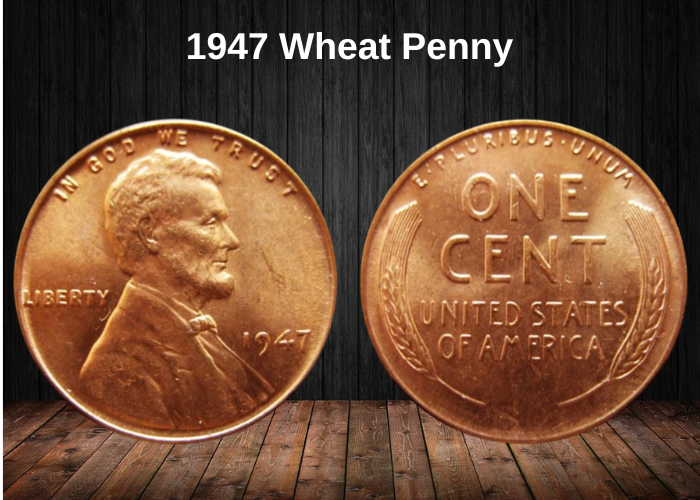
The 1947 penny is part of a series with a rich history that dates back to the early 1900s. In 1909, the United States celebrated the centenary of Abraham Lincoln’s birth, and the nation sought a way to honor the beloved president.
Until that time, it was uncommon for real people to be featured on coins. Such an act was considered something monarchies did, not republics. However, as public support for a Lincoln commemorative coin grew, the U.S. Mint responded.
In 1909, the first Lincoln penny was issued, featuring a portrait of President Lincoln on the obverse. The reverse design depicted two ears of wheat, which led to the coin’s alternative name, the Wheat penny.
This iconic design remained unchanged for fifty years, including on the 1947 penny, which is both a Lincoln and a Wheat penny.
Evolution of the Design:
In 1959, to commemorate 150 years since Lincoln’s birth, the reverse design of the coin was altered. It was redesigned again in 2009 for the bicentennial of Lincoln’s birth, and once more in 2010. However, the obverse design, showing Lincoln’s portrait, has remained unchanged, making it the longest-running design in U.S. coinage history.
Popularity and Initial Reaction:
When the first Lincoln pennies were released, they were incredibly popular. People rushed to banks to obtain them, and they were seen as valuable collector’s items, often trading for up to 25 times their face value.
However, not everyone was thrilled. The vending machine industry complained that the new coins were too thick to fit into machine slots. Despite this, the U.S. Mint refused to alter the coin, so vending machines had to be re-engineered to accommodate them.
Proof Pennies:
Proof pennies were first struck in 1936 at the Philadelphia Mint using specially prepared planchets and dies, and they were aimed at collectors. These proof coins were made in several years but not in 1947.
Minting Locations and Composition:
In 1947, pennies were minted at three locations:
- Philadelphia (no mint mark)
- Denver (mint mark: “D”)
- San Francisco (mint mark: “S”)
The 1947 pennies were made from bronze, a mixture of copper, tin, and zinc. This was the same composition used for Lincoln pennies since 1909, except for the unusual year of 1943, when the war effort led to the production of pennies made from steel instead of copper.
The 1947 penny, like others in the series, is a collectible piece of history, with variations depending on the mint and condition, and continues to be of interest to numismatists and collectors today.
Features of the 1947 Wheat Penny
The Obverse of the 1947 Wheat Penny
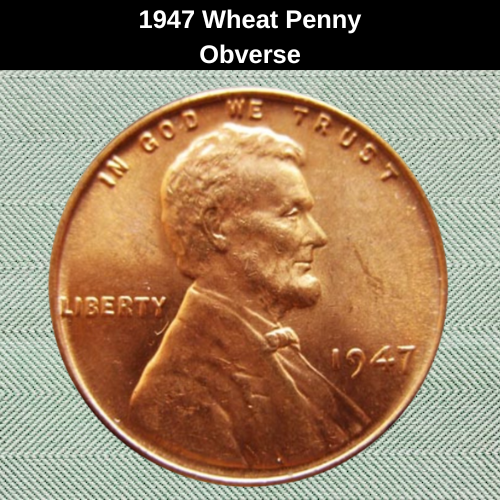
The portrait of Abraham Lincoln on the 1947 penny is the work of Victor David Brenner, a renowned artist who also designed the medal for the Panama Canal Commission, which caught the attention of President Theodore Roosevelt. This led to Brenner being commissioned to design the new Lincoln penny.
Brenner’s portrait shows Lincoln in profile, facing to the right, and he aimed to capture a lively expression, imagining what Lincoln might have looked like while reading to a child. This artistic choice was meant to humanize the president, showing him in a more approachable light.
Modifications Over Time:
The version of Brenner’s design on the 1947 Wheat penny differs slightly from the original. Notably, Lincoln’s cheek and coat are smoother on this coin. In 1916, Charles Barber, then the Chief Engraver at the Mint, made modifications to the design to prolong the life of the dies used in production. These changes helped ensure that the coin’s details could be preserved through extensive minting.
Design Features:
- The motto “IN GOD WE TRUST” is inscribed above Lincoln’s portrait, curving along the top edge of the coin.
- To the left of Lincoln, you’ll find the word “LIBERTY.”
- The date appears on the lower-right side of the coin.
Mint Marks:
- Coins minted in Denver will have a mint mark “D” beneath the date.
- Those minted in San Francisco will feature a mint mark “S.”
- If there’s no mint mark, the penny was struck at the Philadelphia Mint.
This design, with Lincoln’s profile and the detailed inscriptions, is iconic and remains a symbol of American coinage history.
The Reverse of the 1947 Wheat Penny
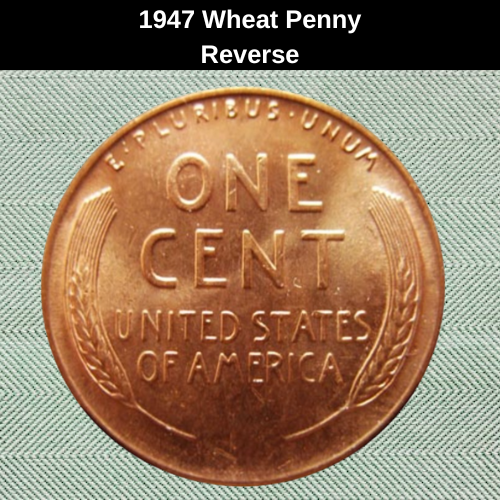
The reverse of the 1947 Wheat penny features a pair of ears of durum wheat. These stylized representations curve upwards along either side of the coin, framing the denomination “ONE CENT” prominently in the center. Below the denomination, the phrase “UNITED STATES OF AMERICA” is inscribed, indicating the coin’s origin.
At the top of the reverse, arching parallel to the upper edge, are the words “E PLURIBUS UNUM,” which is Latin for “From many, one.” This phrase reflects the unity of the United States as a union of individual states.
Historical Details:
- The very first Lincoln pennies had Victor David Brenner’s initials (“VDB“) on the reverse, near the bottom. However, these initials were considered too bold and somewhat like an advertisement for the artist’s work. As a result, production was halted early in 1909, and the initials were removed from the reverse. They were later reinstated on the obverse of the coin in 1918.
This reverse design remained a constant feature on the Lincoln Wheat penny from 1909 until 1958, when it was replaced by the Memorial cent design. The Wheat penny, with its iconic ears of wheat and Latin inscription, remains one of the most recognized symbols of American coinage.
Other Features of the 1947 Wheat Penny
- Dimensions and Weight: The 1947 Wheat penny has a diameter of 19 millimeters and weighs 3.11 grams.
- Composition: It is made of 95% copper, with the remaining 5% made up of tin and zinc.
Color Variations:
Due to its high copper content, the color of the 1947 Wheat penny can vary significantly over time. When new, the coin has a rich red tone, but with age, exposure to the air, and handling, it can transition to brown.
- Red Coins: These are coins that retain their red color over at least 95% of their surface area. They are typically the most desirable to collectors.
- Red and Brown Coins: These coins have a combination of red and brown, with red covering between 5% to 95% of the surface.
- Brown Coins: These coins are predominantly brown and are generally less sought after by collectors.
Collectibility:
- Red coins are typically considered the most valuable among collectors, while brown coins tend to be less valuable.
For those interested in learning more about grading the color of their Wheat pennies, there are several resources available, such as the CoinOpp YouTube video that provides a detailed explanation on grading.
1947 Penny Grading
The grading system for 1947 pennies, like all coins, helps collectors and dealers determine a coin’s condition and, in turn, its value. Here’s a breakdown of the standard coin grades used for the 1947 Wheat penny:
| Grade | Description |
|---|---|
| 1 (Basal State-1) | Very worn, with little to no detail visible. |
| 2 (Fair) | Major wear, with some detail visible. |
| 3 (Very Fair) | Significant wear, but a bit more detail visible. |
| 4, 5, 6 (Good) | Considerable wear, with most features visible but faint. |
| 7, 8, 10 (Very Good) | Significant wear, but more detail remains. |
| 12, 15 (Fine) | Moderate wear, with features clearly visible. |
| 20, 30 (Very Fine) | Light wear, with all details sharp. |
| 40 (Extremely Fine) | Very light wear, near full detail. |
| 50 (About Uncirculated) | Minor wear, almost mint condition. |
| 60, 65 (Mint State) | Coin has never been circulated, and shows no wear. |
| 70 (Mint State) | Perfect, flawless coin in mint condition. |
To accurately assess the value of your coin, it’s important to know its grade. Use a grading guide to help determine where your 1947 penny falls on the scale. A higher grade generally translates to higher value.
1947 Wheat Penny Value Guides
1947 No Mint Mark Wheat Penny Value
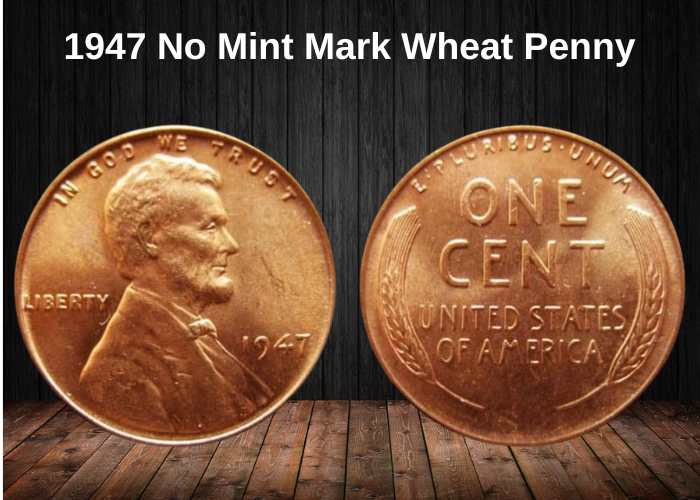
The condition of a coin is a crucial factor in determining its value, and for 1947 Wheat pennies, the grading scale plays a pivotal role. Here’s an overview of how the condition of a 1947 penny influences its value:
- Coin Condition and Grading:
- 1 to 70 Scale: The scale ranges from 1 (the worst condition where the coin is still identifiable) to 70 (flawless, perfect condition).
- Mint State (MS): Coins in uncirculated condition are graded between 60 to 70. These coins are typically the most valuable, especially when in the higher grades (65+).
- Gems: Coins with a grade of 65 or above are considered “gems,” and they hold the highest value.
- Mintage and Survivability:
- In 1947, the Philadelphia Mint struck over 190 million Wheat pennies.
- PCGS estimates that about 19 million of those coins survive today.
- Most of the surviving coins are brown pennies in circulated condition, which typically only hold face value unless there’s a notable mint error.
- Value by Condition:
- Brown and Red-Brown Coins: These coins, unless they have mint errors, generally don’t fetch much over face value, especially if they are circulated.
- Red Pennies: Of the surviving pennies, 7,000 are red. These are the most sought after.
- At MS60, a red penny can be worth around $5.
- At MS63, the value increases to $10.
- At MS65, these coins can be worth around $26.
- At MS66, they reach approximately $140.
- MS67 red pennies can command up to $2,200.
- The Finest Survivors:
- The highest-grade MS67+ red pennies are extremely rare, with only 2 certified coins at this grade.
- These two MS67+ coins are valued at approximately $17,500 each.
In summary, the most valuable 1947 Wheat pennies are red and in high mint state grades, particularly MS67 and higher. The majority of surviving coins, however, will be worth only a few dollars unless they have specific errors or higher grades.
1947 D Wheat Penny Value
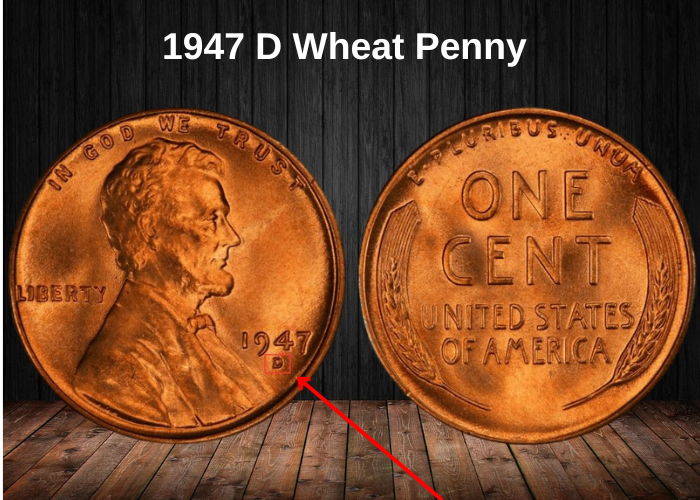
The Denver Mint struck nearly 195 million Wheat pennies in 1947, and the values for D mint mark coins generally follow the same trends as their Philadelphia counterparts, with some differences at the higher grades. Here’s a breakdown of the value for the 1947 D Wheat penny based on its condition:
- General Value Trends:
- For brown and red-brown 1947 D Wheat pennies, unless they feature a significant mint error, they will typically only be worth face value unless they are in high mint state grades.
- Red Pennies:
- MS62: Red pennies start at around $7 for those in mint state.
- MS65: These coins can be worth around $18, especially if they are well-preserved gems.
- MS67: At this level, the value jumps to $325, reflecting their superior condition and desirability among collectors.
- Top-Tier Collectibles:
- MS67+: The highest-grade 1947 D Wheat pennies are extremely rare, with only 15 coins certified at this level by the PCGS.
- These top-tier coins are worth around $3,000 each, making them highly sought after in the coin-collecting world.
In summary, 1947 D Wheat pennies will generally be valued similarly to their Philadelphia counterparts for most grades, but the most valuable coins are those in MS67 and MS67+ grades. As with all collectible coins, the condition of the penny plays a significant role in determining its market value.
1947 S Wheat Penny Value

The San Francisco Mint facility produced 99 million Wheat pennies in 1947, fewer than the Philadelphia and Denver mints. However, a significant number of these coins have survived, with an estimated one in ten still in circulation today. Notably, the red coins are more likely to have survived in good condition, with an estimated 13,000 red pennies still around.
Here’s how the value of 1947 S Wheat pennies breaks down based on condition:
- General Value Trends:
- For most brown and red-brown coins, the value will be close to face value unless they are in excellent condition.
- Red Pennies:
- MS60: Red pennies in mint state start at around $2.
- MS65: These coins are valued at $24, though they are significantly more collectible than lower grades.
- MS67: At the MS67 grade, red pennies can be worth up to $240, reflecting the premium for high-grade examples.
- Top-Tier Collectibles:
- MS67+: This is the highest grade yet awarded to 1947 S Wheat pennies, with 22 coins certified at this level.
- These coins are valued at around $1,100 each, making them the most sought after among collectors.
- Occasional Surprises:
- A brown MS65 1947 S penny broke expectations in 2011 when it sold at auction for $150, far exceeding the typical value for brown coins in this grade.
In summary, 1947 S Wheat pennies will generally have values similar to those produced at Philadelphia and Denver, but the red coins in high mint state grades stand out as the most valuable. Coins in the MS67+ grade, although extremely rare, are especially prized among collectors and can command values of $1,100.
Rare 1947 Wheat Penny Errors List
1947 (P) No Mint Mark Wheat Penny, Double Die Obverse
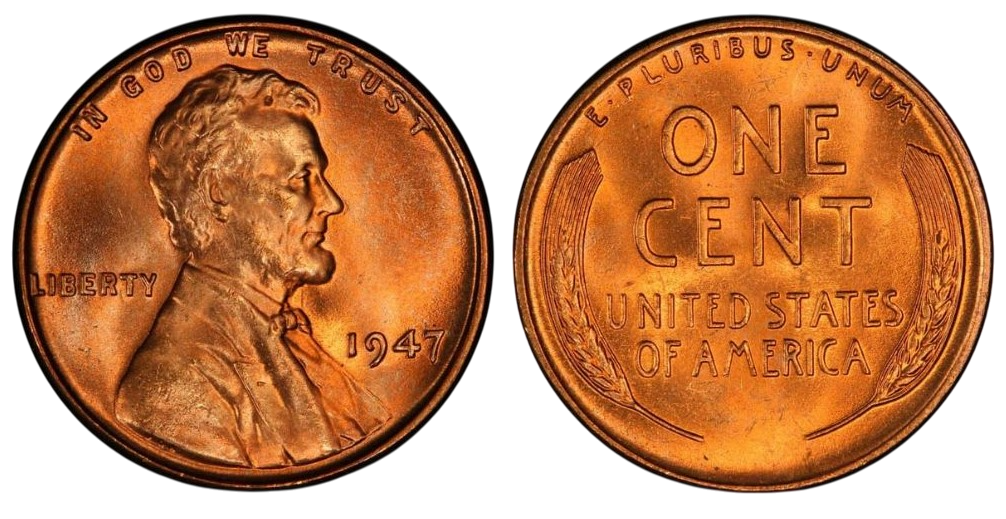
Some 1947 Philadelphia Wheat pennies have a double die obverse error. This error occurs when the die used to strike the coins was improperly aligned during the minting process, causing the design to be struck more than once. The most noticeable feature of this error is the double lines on the date, especially on the bottom of the “1” and the top of the “7”.
To spot this error, you’ll likely need a microscope or loupe to clearly identify the double lines.
Value of Double Die Obverse Error Coins
The value of a 1947 double die obverse coin depends on its condition. Here’s how the values break down based on grade:
- Brown Coins:
- A brown AU53 (About Uncirculated) coin with this error sold for $94 at auction in 2013.
- Red and Brown Coins:
- MS62 red and brown coins with the double die error sold for $45 in 2012 and $79 in 2013.
- A red and brown MS65 coin with this error was being offered online for $345 as of the latest update.
- Red Coins:
- A red MS65 coin with the double die obverse error sold for an impressive $550 at auction in 2014.
In summary, coins with this double die obverse error are valuable, especially in mint state grades. The red coins with this error tend to command the highest prices, particularly those in MS65 condition or higher.
1947 S/S Wheat Penny – Re-punched Mint Mark
Some 1947 Wheat pennies minted at the San Francisco Mint feature a re-punched mint mark. This error occurs when the mint mark, in this case, the “S”, was struck more than once, creating a shadow of the earlier “S” below the final one.
To identify this error, you’ll need to closely examine the coin with a microscope or loupe.
Value of 1947 S/S Re-punched Mint Mark Coins
As with other error coins, the value depends on the condition of the coin. Here are the current values based on the grade:
- Brown Coins:
- A brown AU55 (About Uncirculated) coin with the re-punched mint mark sold for $83 at auction in 2015. However, this price seems relatively high compared to current market trends.
- Red Coins:
- MS60 graded red coins with this error are currently valued at $40.
- A MS65 red coin can fetch around $150.
- Top Condition Red Coins:
- MS67 red coins are the highest grade, with three of them valued at $800 each.
In summary, 1947 S/S re-punched mint mark coins are collectible and can be valuable, especially in red and higher mint state grades.
Where to sell your penny?
Now that you know the value of your penny, you might be wondering where to sell it. Don’t worry: here’s a guide to some of the best online platforms where you can easily sell your coins, along with their advantages and disadvantages.
Discover the best platforms for selling coins online (pros and cons).
FAQs
1. Why is the 1947 Wheat Penny significant in U.S. coinage history?
The 1947 Wheat Penny is significant because it marks the second-to-last year of the Wheat reverse design, just before the U.S. Mint switched to the Lincoln Memorial reverse in 1959. This penny represents a continuation of the classic design that has been in circulation since 1909. The 1947 penny also came out during a time when the U.S. economy was recovering from World War II, as the country began its post-war economic boom.
2. What is the metal composition of the 1947 Wheat Penny?
The 1947 Wheat Penny is made from:
- 95% copper
- 5% zinc
This composition was used for pennies from 1909 through 1942, with a brief interruption in 1943 when the U.S. Mint switched to steel pennies due to wartime copper shortages. After 1944, copper was again used for the production of pennies, and this composition continued through the end of the Wheat design.
3. How many 1947 Wheat Pennies were minted?
The 1947 Wheat Penny was minted in large numbers, ensuring it was widely circulated:
- Philadelphia (no mintmark): 1,088,460,000
- Denver (D): 282,760,000
- San Francisco (S): 113,190,000
With over 1.4 billion coins produced, the 1947 Wheat Penny is fairly common in most conditions, making it relatively easy to find in circulated form.
4. What is the value of a 1947 Wheat Penny today?
The value of a 1947 Wheat Penny varies depending on its condition:
- Circulated coins: Generally worth $0.05 to $0.25 in common grades.
- Uncirculated coins: Depending on the grade, they can range from $1 to $10 for MS-63 or MS-64 grades.
- High-grade examples (MS-65 or better) can command $20 or more.
The 1947 penny’s value is still moderate because of its high mintage, but coins with error varieties or those in exceptional condition can fetch higher prices.
5. Are there any notable varieties or errors in the 1947 Wheat Penny?
Yes, like many U.S. coins, the 1947 Wheat Penny has some notable error varieties and features:
- Double Die Obverse (DDO): Some 1947 pennies feature a doubled die on the obverse, often affecting the inscriptions “LIBERTY” and “IN GOD WE TRUST”. These coins are sought after by collectors due to their distinct features.
- Off-center Strikes: These coins are struck with part of the design missing due to improper alignment during the minting process.
- Die Cracks and Cuds: These are more minor but still notable for collectors interested in die errors. Some 1947 pennies have visible cracks or imperfections on the coin’s edge or design.
If you come across a 1947 Wheat Penny with an error, it can be valuable, especially if it is well-preserved.
6. How does the 1947 Wheat Penny compare to other Wheat Pennies like the 1944 or 1948?
- 1944: The 1944 Wheat Penny is often remembered for being struck in copper recycled from spent shell casings after WWII, a notable piece of U.S. wartime history. It also had the infamous 1944 steel cent error.
- 1948: The 1948 Wheat Penny is one of the last coins with the Wheat reverse design before the transition to the Lincoln Memorial reverse. However, unlike the 1947 penny, the 1948 coin is rarer in certain grades, and in higher uncirculated grades, it tends to be more valuable.
In general, the 1947 penny is still widely available, while the 1944 penny is more famous due to the war and the 1944 steel error, making it more collectible in error form.
7. How can I identify a high-grade 1947 Wheat Penny?
To identify a high-grade 1947 Wheat Penny, collectors should focus on:
- Sharp, clear details: The details in Lincoln’s portrait, the wheat stalks, and the inscriptions should be well-defined, with minimal signs of wear.
- Clean surfaces: The coin should be free of scratches, tarnish, and heavy bag marks. A well-preserved coin will have smooth surfaces and no noticeable defects.
- Luster: High-grade uncirculated coins (MS-63 or above) will have bright, reflective surfaces with good eye appeal and a noticeable shine. There should be no signs of wear on the high points of the coin, such as Lincoln’s face and the wheat stalks.
Coins graded MS-65 or higher are the most valuable and typically demand a premium on the market.



















































